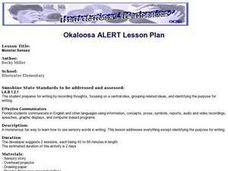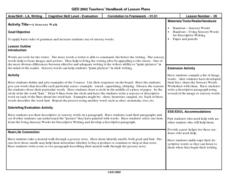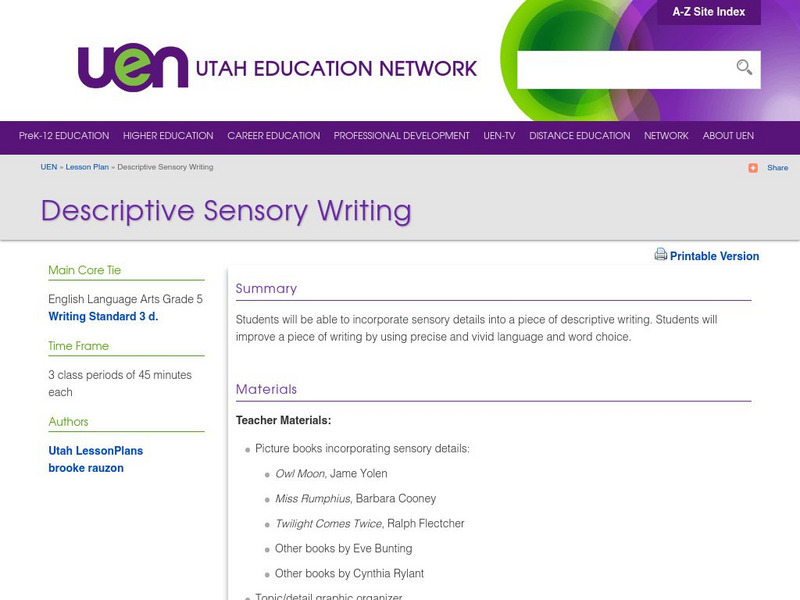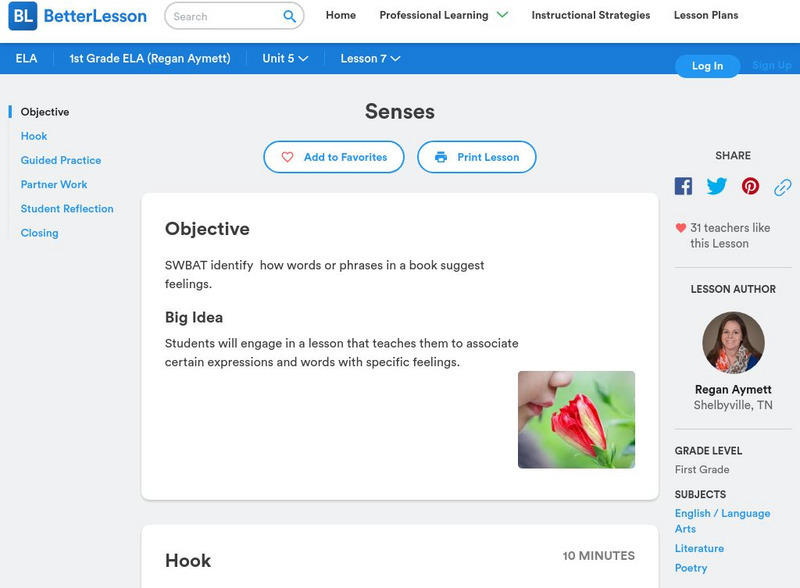Curated OER
Setting Worksheet
Set your class up for success with writing descriptive settings with these two graphic organizers. On the first page, writers note specifc details about their chosen setting and comment on how each character views the setting. The second...
Curated OER
From Light to Dark and Back
Experiment with light and dark in a series of interactive activities that lead up to reading and writing poetry. Class members have the opportunity to observe their feelings while sitting in the light and dark and to play with shadow...
Curated OER
Lesson Plan: Sensory Exploration
Using their keen eyes and ears, learners build story observation skills which they will use to create sensory detail in their art. They note all of the things they observed on a walk, categorize them by sense, and then use the same skill...
Curated OER
Poetry Writing Unit: Writing a Film Poem
Film poems? To concluded a poetry unit, writers select one of their own poems and create a film that brings to life the sounds and images of their work. Included with the detailed unit plan are daily lessons, student examples, a list of...
Curated OER
"Snapshot" Exercises & Sensory Detail Word Bank
Read a sample of creative descriptive writing to your science class. Discuss how writing can be used to record and communicate observations that scientists make. Reading selections and thought-provoking questions are suggested. Also...
Curated OER
Setting the Tone with Figurative Language
Explore figurative language with your secondary class. Extending a language arts unit, the lesson plan prompts middle schoolers to examine how an author's word choice establishes a story's tone, possibly using metaphors, similes,...
Curated OER
Let's Go Exploring!
Use a Courbet painting of a cave or tunnel opening to reinforce the importance of descriptive writing. Writers of all ages use sensory details to describe what the scene depicts as they pretend to be in the painting. Then they imagine...
Curated OER
A Seashell Lesson: Writing for Detail and the Scientific Process
Practice descriptive language in this lesson, which prompts elementary and middle schoolers to write detailed descriptive sentences describing a seashell. They write a description of a shell, create an illustration, and other students...
Curated OER
Printable Story Starter: Treasure in the Daisies
Class members can practice using sensory details and imagery with this writing prompt, which provides a vivid introduction about a girl who discovers a treasure box in her mother's garden. The middle, ending, and title of the story are...
Curated OER
Logs, Charts, and Journals: What's On Your Plate?
Have your writers identify and use words that appeal to the senses. They create a chart of sensory words and record some of their favorites, then write a journal entry in which they describe eating at a restaurant using sensory details....
Curated OER
Polar Bear Literacy Activity
Students generate vocabulary words synonymous or related to "noise." In this literacy lesson, students listen to the book Polar Bear, Polar Bear, What do You Hear? by Bill Martin and Eric Carle and discuss the meaning of vocabulary words...
Curated OER
A Sense of Place
Learners read "Fish Tale: Falling For a Live One" from The New York Times and discuss the methods and techniques the writer uses to create a strong mental image. Students pick a place in their community they wish to write about and...
Curated OER
Chef for a Day
Students make chocolate chip cookies. In this cooking lesson, students follow a recipe by doing each step in sequence.
Curated OER
Monster Senses
Second graders listen to a story that contains many sensory words to describe an object. They listen a second time using a signal to indicate when they hear a sensory word. They write a short story about a monster using appropriate...
Curated OER
A Sensory Walk
Students define and give examples of five senses, compiling a list of sensory words to be used in a written descriptive paragraph.
Utah Education Network
Uen: Descriptive Sensory Writing
In this lesson, 5th graders will engage in descriptive writing. Students will improve a piece of writing by using precise word choices that are full of sensory word choices.
Education.com
Education.com: Words That Make Us Feel: A Lesson on Sensory Language
[Free Registration/Login Required] After this lesson centered around the book Owl Moon, students will be able to identify words and phrases that suggest feelings and appeal to the senses.
Texas Education Agency
Texas Gateway: Imagery (English Iii Reading)
In this lesson, students will learn how writers use words that allow them to create pictures in their heads. When a writer uses sensory details or words that appeal to our senses, then we are able to use our senses and our memory to...
Better Lesson
Better Lesson: Senses
Students will engage in a lesson that teaches them to associate certain expressions and words with specific feelings. Included are a senses PowerPoint, a model of a graphic organizer, and a video and picture of the students engaged in...
Writing Fix
Writing Fix: Colorful Sensory Poems
This lesson plan allows students to explore color - both in literal and figurative terms. Students will read books about color, discuss the emotion involved with color, and incorporate color metaphors to write poems using the graphic...
Writing Fix
Writing Fix: The Sum of Its Parts
Inspired by Julianna's understanding (from the novel Flipped by Wendelin Van Draanen) that "A painting is more than the sum of its parts," learners will describe a memorable place that evokes a certain feeling or emotion. Students will...
Read Works
Read Works: Spring
[Free Registration/Login Required] Four three-lined poems describing the spring season. A question sheet is available to help students build skills in reading comprehension.
Sophia Learning
Sophia: Writing Narratives
Notes, a PowerPoint presentation, two videos, a song, an exercise, and a game help students to understand how to write a narrative. Elements of a narrative as well as the use of figurative language and sensory images are introduced and...
CPALMS
Cpalms: Reading With Our Eyes, Fingers, Toes, Ears and Nose
[Free Registration/Login Required] In this lesson, students are learning to identify sensory words in their reading, specifically in poetry. Students will gain a perspective on how authors use sensory words to portray their ideas. They...

























